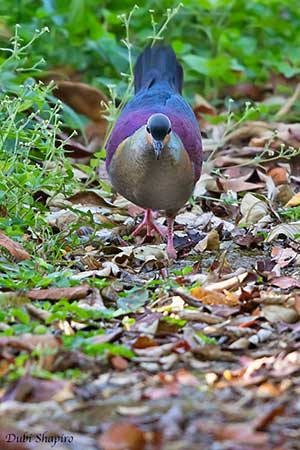
Fr: Colombe versicolore
Ang: Crested Quail-Dove
All: Kurzschopftaube
Esp: Paloma perdiz jamaicana
Ita: Tortora quaglia crestata
Nd: Kuifkwartelduif
Sd: tofsvaktelduva
Photographer:
Dubi Shapiro
Dubi Shapiro Photo Galleries & Dubi Shapiro's Pictures on IBC
Text by Nicole Bouglouan
Sources:
HANDBOOK OF THE BIRDS OF THE WORLD vol 4 by Josep del Hoyo-Andrew Elliott-Jordi Sargatal - Lynx Edicions - ISBN: 8487334229
PIGEONS AND DOVES by David Gibbs, Eustace Barnes and John Cox - Pica Press Sussex - ISBN: 1873403607
BIRDS OF THE WEST INDIES – by Herbert Raffaele, Kristin Williams et Tracy Pedersen – Helm – ISBN: 9780713649055
A Photographic Guide to the Birds of Jamaica by Ann Haynes-Sutton, Yves-Jacques Rey-Millet, Audrey Downer, Robert Sutton – Editor: Bloomsbury Publishing, 2010. ISBN: 1408133229, 9781408133224 - 336 pages
Neotropical Birds – Cornell Lab of Ornithology
Crested Quail-Dove
Geotrygon versicolor
Columbiformes Order – Columbidae Family
INTRODUCTION:
The Crested Quail-Dove is endemic to Jamaica where it frequents montane forest up to 1,800 metres of elevation.
It feeds on seeds and small fruits found on the ground. It nests in a cup-shaped structure close to the ground and sometimes on the ground. Both parents share the nesting duties.
This dove is known for its mysterious moaning call, but the song is heard more often than the bird is seen.
The Crested Quail-Dove is threatened by habitat loss through clearance for plantations and farming. This species is currently classified as Near Threatened.

DESCRIPTION OF THE BIRD:
Biometrics:
Length: 27-31 cm
Weight: 225 g
The Crested Quail-Dove is a plump, ground-dwelling bird.
Upperparts and tail are slate-grey to greenish-black, with purple iridescence, especially on mantle and wing-coverts. Hindneck and upper mantle are glossed bronze-green.
The underparts are dark grey, with chestnut belly and flanks. The bird appears generally dark.
On the head, face and neck are grey, with stiff feathers on the greyish-black forehead. Crown and nape are dull brown, mostly grey at sides and rear. There is a reddish-buff median line on throat and a broad malar stripe across the face. Head and nape feathers form a small crest, especially on nape.
The short bill is blue-grey to blackish. The eyes are red, surrounded by narrow, dull red orbital ring. Legs and feet are pink.
The female is similar, but she may be sometimes paler and browner on neck and belly.
The juvenile is duller than adults. It has olive-brown upperparts with reddish edges to feathers.
RANGE:
The Crested Quail-Dove is endemic to Jamaica. It is locally fairly common, especially in the Blue Mountains and Cockpit Country.
HABITAT:
The Crested Quail-Dove frequents the primary wet montane forest where it occurs mainly in undisturbed, dense understorey and limestone hills. It may enter secondary growth adjacent to primary forest.
CALLS AND SONGS: SOUNDS BY XENO-CANTO
The Crested Quail-Dove has mysterious moaning call, a mournful 2 to 3 syllabled “woof-woo-wooo” with sharp first note and softer and lower-pitched following notes.

BEHAVIOUR IN THE WILD:
The Crested Quail-Dove feeds on seeds, small fruits, insects, grubs, snails and caterpillars.
It feeds on the ground, on the forest floor, foraging among the leaf litter. It can be seen along trails and road edges.
While walking, the bird pumps the head and bobs the tail. If threatened, it flushes a short distance into the vegetal cover.
The Crested Quail-Dove breeds from March to June. The nest is typical of Columbidae, a coarse platform of twigs placed close to the ground, or occasionally on the ground. Both adults share the nesting duties.
The male displays during the day by calling from low perch or from the ground.
The Crested Quail-Dove is resident in Jamaica.
The flight is short and heavy. If alarmed, it prefers to escape by running.

REPRODUCTION OF THIS SPECIES:
The breeding season takes place between March and June.
The pair builds a cup-shaped nest with twigs in the vegetation, usually close to the ground or sometimes on the ground.
The female lays two buff eggs. The incubation lasts 13 days, shared by both adults. The male incubates during the day, while the female incubates in the evening and at night.
At hatching, the downy chicks are fed by regurgitation of “crop-milk”, a very nutritious food. They fledge about 12 days after hatching, and get soon the adult plumage.
PROTECTION / THREATS / STATUS:
The Crested Quail-Dove has restricted range. It is threatened by habitat loss and degradation for the establishment of coffee and Pinus caribaea plantations, farming and clearance of forest.
This species is also trapped for cage-bird trade and for human consumption.
The population is suspected to decrease slowly and the bird is described as uncommon.
The Crested Quail-Dove is currently classified as Near Threatened.
